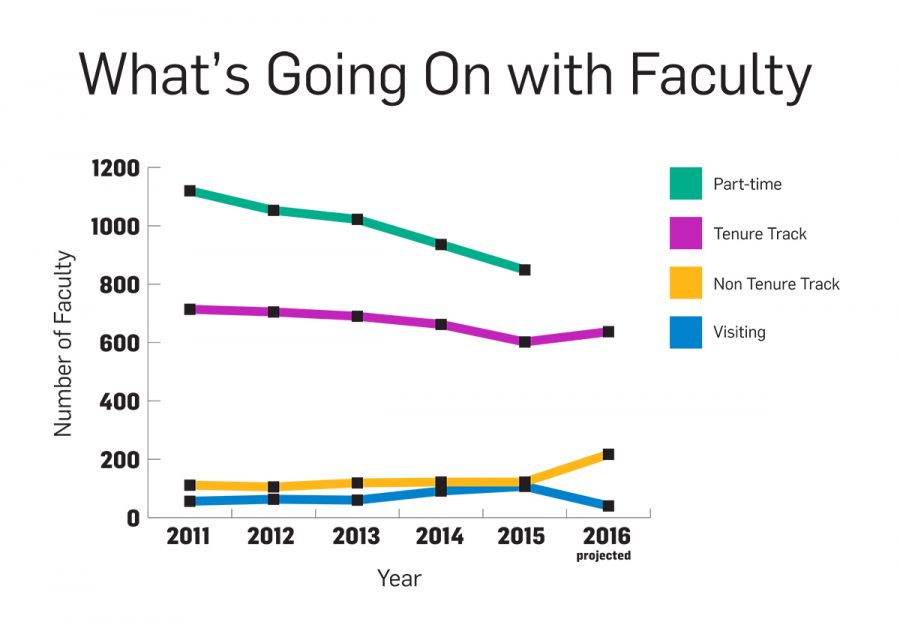Fewer visiting, more full-time faculty
Temporary lecturers’ contracts not to be renewed next fall
In 2011, the total number of faculty at UA was 2,001. Each year since, that number has declined to its 2015 total of 1,680. This trend, broken up into the four types of faculty at UA, is illustrated above. There is no projected figure for part-time faculty in 2016 because that statistic is dependent on enrollment, which is not yet known.
April 27, 2016
For next fall, The University of Akron administration is trying to cut back the number of visiting lecturers to make room for more full-time, bargaining-unit (union) faculty.
There are about 100 temporary visiting lecturers (TVLs) at the University. Their jobs are designed to be for the short-term, with lecturers staying on campus for only one semester or one year to teach.
In recent years the same TVLs’ contracts have been renewed year after year, so that their jobs have become more “permanent” than “temporary.”
TVL contracts also expire at the end of the semester. So news that these visiting lecturer positions will not be renewed next fall – with not as many full-time positions to replace them – has caused many to wonder or be upset at what seems to be a further shift away from academics by the UA administration.
So in a sit-down interview with The Buchtelite, UA Senior Vice Provost Rex Ramsier gave the story behind the administration’s desire to shift from visiting to full-time faculty, which he says is critical to understand, but is often not, even by faculty themselves.
The Affordable Care Act was passed in 2010. It required all employers to track their part-time employees’ hours, and mandated that any part-time employee who worked more than 30 hours a week – or 75 percent of a full-time workload – receive health coverage from their employer.
But the ACA left the regulations on how to make this change unclear, especially in regard to colleges and universities and their treatment of part-time faculty, or adjuncts.
Up until the ACA passed, part-time faculty at UA were eligible to teach 21 credit hours per year – typically 12 one semester, and nine the next. But because teaching 12 credit hours is considered a full-time load, the UA administration had to cut down on the number of credit hours part-time faculty could teach per semester after the ACA was passed. So they limited that number to eight credit hours per semester.
“Because we had 1,000 part-time faculty,” Ramsier said, “we couldn’t afford to have them all overnight become eligible for benefits. We hadn’t budgeted for that.”
Ramsier said there was “legitimate pushback” on campus once the eight credit hour rule was announced – partly because many part-timers taught more credit hours than full-timers in the same department, and partly because many part-timers relied on their wages to live, which would be severely reduced by the eight credit hour restriction.
So the administration added a new classification of professors: full-time TVLs. These positions were largely made up by the part-timers who were affected by the eight credit hour limit. As TVLs, though, they would once again get a full-time credit hour workload, but would now also receive higher salaries and benefits.
“We did what I consider to be the morally right thing to have done,” Ramsier said. “So we spent more money to hire [part-timers] as TVLs, and gave them benefits. And that has gone on now for a couple years.”
Since then, the ACA rules have become more clear, and UA was able to bump up the limit on part-time faculty to nine credit hours. Yet there are still the many TVL positions being renewed year after year.
“If you keep renewing them…it goes against the definition of what it means to be temporary or visiting,” Ramsier said. “And it begins to look like you’re sort of abusing the role and the system,” because TVLs are not in the faculty union (Akron-AAUP), and therefore do not have the same contractual privileges as those who are.
This is why now, though it will cost more money, the administration is trying to get rid of the temporary visitor positions and add full-time positions, Ramsier says.
There are about 140 bargaining-unit faculty positions posted now, for which UA is looking to hire. The hiring process goes mainly through the current faculty themselves, who set up committees and make final hiring recommendations.
TVLs can apply for these positions, though it is not guaranteed they will get one. Ramsier said whoever does end up filling the new positions, will likely be doing the work of the current TVLs.
It is also not a one-to-one ratio, meaning that not every TVL whose contract is not renewed will be replaced by a full-time professor. This is partly because of declining enrollment, partly because the University can’t afford it, and partly because some departments might need bargaining-unit faculty for their growing sides, and can afford to replace TVLs with part-timers in other areas.
The full-time positions will cost UA more money.
“It’s an investment in educational quality,” Ramsier said. “But they’ll then have the option, also, for multi-year contracts, so it’s more of a career for people who want to teach, earn advance rank and, one day, multi-year contracts.”
Ramsier also made a comment on the downward trend of the number of part-time faculty at the University, saying that fewer of them are needed when there is both declining enrollment and more full-time faculty.
If a department’s full-time faculty postings have not gone up yet, it is unlikely those positions will be filled by fall. For that reason, TVL contracts in that academic area will likely be renewed for next year.
This process is “Phase II” of the faculty hiring plan, according to Ramsier. Phase I was last semester, when 55 faculty positions of “critical need” – such as faculty in accreditation programs or department chairs – were hired.
“The two goals of Phase II were to limit the number of renewed visiting lecturers, and to look at other requests that hadn’t made the Phase I cut,” Ramsier said. “You have to prioritize.”












